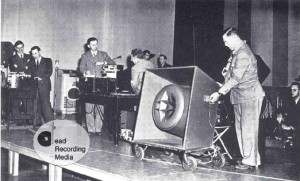Despite its quiet start, it was tape recording that would eventually displace both the phonograph and optical recording methods. Eventually. Captured German recorders were widely copied, improved upon, and re-introduced by Ampex, EMI, and other firms in the late 1940s. Engineers used to editing optical film found it easy to learn to edit tape, and tape represented real improvements over optical recording in terms of convenience and low cost. In radio, record, and movie studios, tape was almost universally adopted by the early 1950s.

A famous demonstration of the German Magnetophon was given in 1946 by Jack Mullin was the stimulus for Ampex to begin tape recorder development. Also featured was the rare and massive Western Electric KS XXX “Tub”
loudspeaker.
The first consumer magnetic recorders also appeared in this period. Inexpensive wire recorders, developed more-or-less independently of the Europeans, were introduced around 1946 and proved to be a short-lived hit. When the first cheap tape recorders appeared around 1948, they soon dominated the market for professional audio recorders.
Millions of tape recorders were sold during the 1950s as part of a boom in sales of “hi-fi” equipment that included AM-FM radio receivers, high-powered amplifiers, record players, and loudspeakers. Tape recorder sales, however, were much lower than record player and radio sales, and many tape recorders owners reported that they made little use of them. Record companies were willing to sell recorded tapes, but they could not compete in price with records, especially the LP record introduced in 1948 by CBS.

